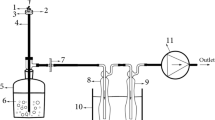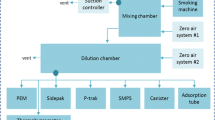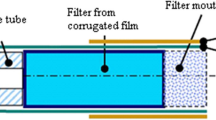Abstract
The use of the waterpipe, a traditional aid for the consumption of tobacco, has spread worldwide and is steadily increasing especially among the youth. On the other hand, there is a lack of knowledge regarding the composition of mainstream waterpipe smoke and the toxicological risks associated with this kind of smoking habit. Using a standardized machine smoking protocol, mainstream waterpipe smoke was generated and further analyzed for twelve volatile organic compounds (VOCs) and eight phenolic compounds by applying gas chromatography–mass spectrometry and reverse-phase high-performance liquid chromatography–fluorescence detection, respectively. Additionally, seventeen elements were analyzed in waterpipe tobacco and charcoal prior to and after smoking, applying inductively coupled plasma–mass spectrometry to assess the maximum exposure of these elements. For the first time ever, we have been able to show that waterpipe mainstream smoke contains high levels of the human carcinogen benzene. Compared with cigarette smoke yields, the levels were 6.2-fold higher, thus representing a significant health hazard for the waterpipe smoker. Furthermore, we found that waterpipe mainstream smoke contains considerable amounts of catechol, hydroquinone and phenol, each of which causing some health concern at least. The analysis of waterpipe tobacco and charcoal revealed that both matrices contained considerable amounts of the toxic elements nickel, cadmium, lead and chromium. Altogether, the data on VOCs, phenols and elements presented in this study clearly point to the health hazards associated with the consumption of tobacco using waterpipes.
Similar content being viewed by others
References
Adam T, Mitschke S, Streibel T, Baker RR, Zimmermann R (2006) Quantitative puff-by-puff-resolved characterization of selected toxic compounds in cigarette mainstream smoke. Chem Res Toxicol 19:511–520
Al Rashidi M, Shihadeh A, Saliba NA (2008) Volatile aldehydes in the mainstream smoke of the narghile waterpipe. Food Chem Toxicol 46:3546–3549
Almeida AM, Castel-Branco MM, Falcão AC (2002) Linear regression for calibration lines revisited: weighting schemes for bioanalytical methods. J Chromatogr B 774:215–222
Barrera-García VD, Gougeon RD, Voilley AE, Chassagne D (2006) Sorption behavior of volatile phenols at the oak wood/wine interface in a model system. J Agric Food Chem 54:3982–3989
Bernhard D, Rossmann A, Wick G (2005) Metals in cigarette smoke. IUBMB Life 57:805–809
Chao HP, Peng CL, Lee CK, Han YL (2012) A study on sorption of organic compounds with different water solubilities on octadecyltrichlorosilane-modified NaY zeolite. J Taiwan Inst Chem E 43:195–200
Chen PX, Moldoveanu SC (2003) Mainstream smoke chemical analyses for 2R4F kentucky reference cigarette. Beitr Tabakforsch 20:448–458
Fowles J, Dybing E (2003) Application of toxicological risk assessment principles to the chemical constituents of cigarette smoke. Tob Control 12:424–430
German Industrial Norm (DIN) (2008) Chemical analysis—decision limit, detection limit and determination limit under repeatability conditions—terms, methods, evaluation. Beuth Publishing Berlin DIN 32645:2008-11
Health Canada Official Method (1999a) Determination of Pyridine, Quinoline and Styrene in Mainstream Tobacco Smoke vol 112. Ottawa, pp 1–11
Health Canada Official Method (1999b) Determination of 1,3-butadiene, isoprene, acrylonitrile, benzene and toluene in mainstream tobacco smoke, vol 116. Ottawa, pp 1–9
Health Canada Official Method (1999c) Determination of phenolic compounds in mainstream tobacco smoke, vol 114. Ottawa, pp 1–11
IARC (International Agency for Research on Cancer) (1999) IARC monographs on the evaluations of carcinogenicity to humans. Re-evaluation of some organic chemicals, hydrazine and hydrogen peroxide. IARC, Lyon
IARC (International Agency for Research on Cancer) (2012a) IARC monographs on the evaluations of carcinogenicity to humans. A review of human carcinogens: chemical agents and related occupations. IARC, Lyon
IARC (International Agency for Research on Cancer) (2012b) IARC monographs on the evaluations of carcinogenicity to humans. A review of human carcinogens: arsenic, metals, fibres, and dusts. IARC, Lyon
Jacob P III, Abu Raddaha AH, Dempsey D, Havel C, Peng M, Yu L, Benowitz NL (2013) Comparison of nicotine and carcinogen exposure with water pipe and cigarette smoking. Cancer Epidemiol Biomarkers Prev 22:765–772
Jawad M, Abass J, Hariri A, Rajasooriar KG, Salmasi H, Millett C, Hamilton FL (2013) Waterpipe smoking: prevalence and attitudes among medical students in London. Int J Tuberc Lung Dis 17:137–140
Khabour OF, Alzoubi KH, Eissenberg T, Mehrotra P, Azab M, Carroll MV, Afifi RA, Primack BA (2012) Waterpipe tobacco and cigarette smoking among university students in Jordan. Int J Tuberc Lung Dis 16:986–992
Leanderson P, Tagesson C (1990) Cigarette smoke-induced DNA-damage: role of hydroquinone and catechol in the formation of the oxidative DNA-adduct, 8-hydroxydeoxyguanosine. Chem-Biol Interact 75:71–81
Maziak W, Nakkash R, Bahelah R, Husseini A, Fanous N, Eissenberg T (2013) Tobacco in the Arab world: old and new epidemics amidst policy paralysis. Health Policy Plan. doi:10.1093/heapol/czt055
Moldoveanu S, Coleman W III, Wilkins J (2008) Determination of hydroxybenzenes in exhaled cigarette smoke. Beitr Tabakforsch 23:98–106
Monzer B, Sepetdjian E, Saliba N, Shihadeh A (2008) Charcoal emissions as a source of CO and carcinogenic PAH in mainstream narghile waterpipe smoke. Food Chem Toxicol 46:2991–2995
Müller F (2014) Personal communication. German Federal Institute for Risk Assessment
Nitsch A, Kalcher K, Greschonig H, Pietsch R (1991) Schwermetalle in Tabaken und in Tabakrauch II: Spurenelemente Cadmium, Blei, Kupfer, Kobalt und Nickel in österreichischen Zigaretten und deren Rauchkondensaten und Rauchgasen. Beitr Tabakforsch 15:19–32
Pistonesi MF, Di Nezio MS, Centurión ME, Lista AG, Fragoso WD, Pontes MJC, Araújo MCU, Band BSF (2010) Simultaneous determination of hydroquinone, resorcinol, phenol, m-cresol and p-cresol in untreated air samples using spectrofluorimetry and a custom multiple linear regression-successive projection algorithm. Talanta 83:320–323
Primack BA, Shensa A, Kim KH, Carroll MV, Hoban MT, Leino EV, Eissenberg T, Dachille KH, Fine MJ (2013) Waterpipe smoking among U.S. university students. Nicotine Tob Res 15:29–35
Robertson ML, Eastmond DA, Smith MT (1991) Two benzene metabolites, catechol and hydroquinone, produce a synergistic induction of micronuclei and toxicity in cultured human lymphocytes. Mutat Res 249:201–209
Saadawi R, Figueroa JAL, Hanley T, Caruso J (2012) The hookah series part 1: total metal analysis in hookah tobacco (narghile, shisha)—an initial study. Anal Methods 4:3604–3611
Schubert J, Hahn J, Dettbarn G, Seidel A, Luch A, Schulz TG (2011a) Mainstream smoke of the waterpipe: Does this environmental matrix reveal as significant source of toxic compounds? Toxicol Lett 205:279–284
Schubert J, Kappenstein O, Luch A, Schulz TG (2011b) Analysis of primary aromatic amines in the mainstream waterpipe smoke using liquid chromatography–electrospray ionization tandem mass spectrometry. J Chromatogr A 1218:5628–5637
Schubert J, Bewersdorff J, Luch A, Schulz TG (2012a) Waterpipe smoke: a considerable source of human exposure against furanic compounds. Anal Chim Acta 709:105–112
Schubert J, Heinke V, Bewersdorff J, Luch A, Schulz TG (2012b) Waterpipe smoking: the role of humectants in the release of toxic carbonyls. Arch Toxicol 86:1309–1316
Schubert J, Luch A, Schulz TG (2013) Waterpipe smoking: analysis of the aroma profile of flavored waterpipe tobaccos. Talanta 115:665–674
Schweigert N, Zehnder AJB, Eggen RIL (2001) Chemical properties of catechols and their molecular modes of toxic action in cells, from microorganisms to mammals. Environ Microbiol 3:81–91
Sepetdjian E, Shihadeh A, Saliba NA (2008) Measurement of 16 polycyclic aromatic hydrocarbons in narghile waterpipe tobacco smoke. Food Chem Toxicol 46:1582–1590
Sepetdjian E, Halim RA, Salman R, Jaroudi E, Shihadeh A, Saliba NA (2013) Phenolic compounds in particles of mainstream waterpipe smoke. Nicotine Tob Res 15:1107–1112
Shihadeh A (2003) Investigation of mainstream smoke aerosol of the argileh water pipe. Food Chem Toxicol 41:143–152
Shihadeh A, Saleh R (2005) Polycyclic aromatic hydrocarbons, carbon monoxide, “tar”, and nicotine in the mainstream smoke aerosol of the narghile water pipe. Food Chem Toxicol 43:655–661
Shihadeh A, Azar S, Antonios C, Haddad A (2004) Towards a topographical model of narghile water-pipe café smoking: a pilot study in a high socioeconomic status neighborhood of Beirut, Lebanon. Pharmacol Biochem Behav 79:75–82
Swami K, Judd CD, Orsini J (2009) Trace metals analysis of legal and counterfeit cigarette tobacco samples using inductively coupled plasma mass spectrometry and cold vapor atomic absorption spectrometry. Spectrosc Lett 42:479–490
Wu J, Rickert WS, Masters A (2012) An improved high performance liquid chromatography-fluorescence detection method for the analysis of major phenolic compounds in cigarette smoke and smokeless tobacco products. J Chromatogr A 1264:40–47
Acknowledgments
The authors would like to thank Philipp Reichardt for excellent technical assistance with the ICP-MS system. This work was financially supported by an internal grant of the German Federal Institute for Risk Assessment (BfR).
Conflict of interest
The authors declare that they have no conflict of interest.
Author information
Authors and Affiliations
Corresponding author
Electronic supplementary material
Below is the link to the electronic supplementary material.
Rights and permissions
About this article
Cite this article
Schubert, J., Müller, F.D., Schmidt, R. et al. Waterpipe smoke: source of toxic and carcinogenic VOCs, phenols and heavy metals?. Arch Toxicol 89, 2129–2139 (2015). https://doi.org/10.1007/s00204-014-1372-x
Received:
Accepted:
Published:
Issue Date:
DOI: https://doi.org/10.1007/s00204-014-1372-x




